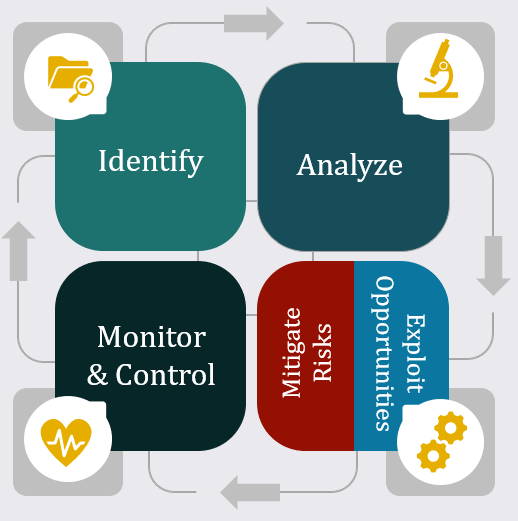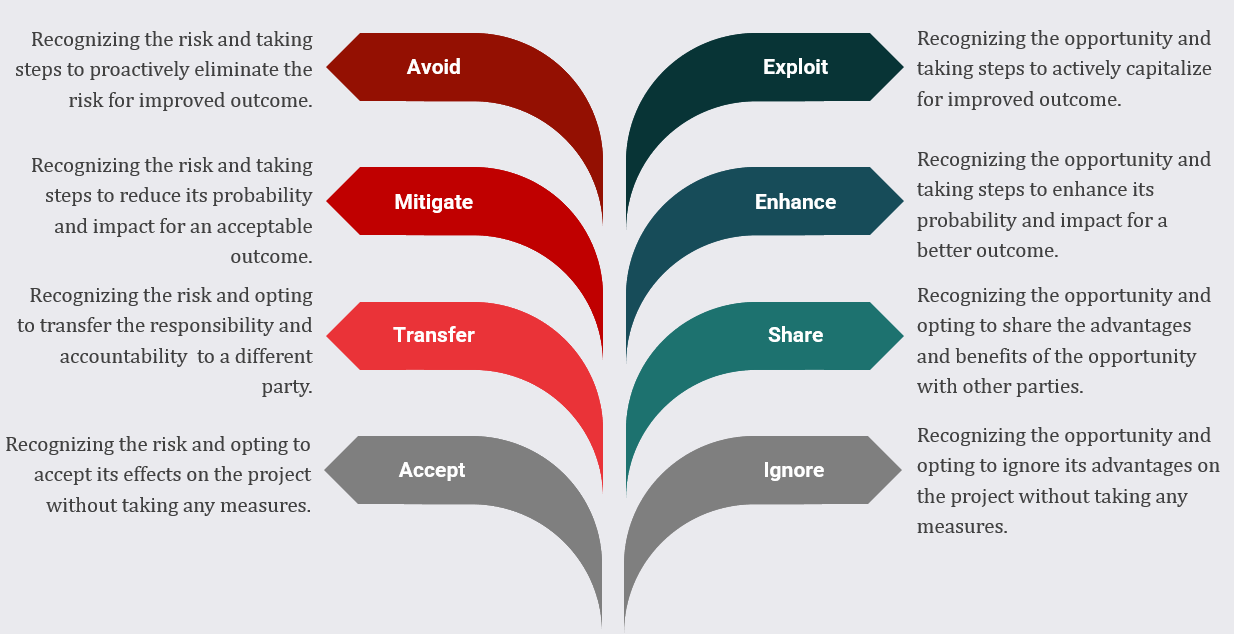The Importance of Seeking and Capitalizing on Opportunities
In project management, risk and opportunity management are interconnected processes where risks focus on potential negative events, and opportunities focus on potential positive events. Risk management aims to mitigate potential adverse events, while opportunity management seeks to capitalize on favorable events to achieve better outcomes like cost savings or improved timelines.
Traditionally, project management has long emphasized the importance of identification and mitigation of risks. While this approach is essential for ensuring the stability and success of a project, it is equally important to seek and seize the opportunities. Opportunities, just like risks, have the potential to significantly impact outcomes, often in a positive and transformative way. In a dynamic and competitive environment, recognizing and capitalizing on opportunities is essential for the sustainability of a project and acts as a driving force for innovation and growth. Prioritizing opportunities alongside risks allows project managers to adopt a holistic approach, ensuring not only the avoidance of pitfalls but also the maximization of benefits.
Understanding Risks and Opportunities
What Are Risks?
Risks are uncertain events or conditions that may adversely affect the progress of a project if they occur. Such risks can lead to unfavorable outcomes including cost overruns, delays, technical failures, and resource shortages. Risk management encompasses the process of identifying, analyzing, and mitigating these potential threats through effective resolution strategies. The objective of risk mitigation strategy is to minimize both the probability and impact of risks by devising measures to avoid, reduce, or transfer them.
What Are Opportunities?
Opportunities, on the other hand, are favorable conditions or events that, if seized, can enhance the project outcomes. They might involve innovative solutions, additional funding, stakeholder partnerships, or unexpected efficiencies. Opportunities are often overlooked in traditional risk management frameworks, yet their proactive integration can lead to remarkable achievements.
Managing Opportunities
Despite its negative connotation, the term "exploit" in the PMBOK guide refers to a proactive response strategy that seeks to identify and act on opportunities to achieve benefits. Effective project management requires a strategic balance between risk mitigation and opportunity exploitation. By managing both aspects, teams can maintain focus on preventing negative occurrences while aiming for positive outcomes.
Key components of opportunity management involve engaging stakeholders and securing leadership commitment to allocate resources for capitalizing and achieving benefits from opportunities. While resources are frequently directed towards risk mitigation, dedicating time, budget, and personnel to exploit opportunities ensures potential rewards are not overlooked. Achieving this balance necessitates strategic planning, foresight, and leadership endorsement.
To effectively manage both, it is advisable to integrate opportunity management into risk management framework and processes. Like the risk management process, which entails identifying, analyzing, and mitigating risks, the opportunity management process involves identifying opportunities, analyzing their likelihood and impact, and strategically exploiting them to maximize benefits. While risks response strategies include accepting, transferring, mitigating, or avoiding risks, the corresponding opportunity response strategies include exploiting, enhancing, sharing, or ignoring an opportunity.
Within the framework and processes of risk management, the Risk Register is a critical document that identifies and tracks all potential risks associated with a project. It serves as a central reference for the project team and aids in prioritizing, monitoring, controlling, and managing risks, ensuring continuous oversight and mitigation of risks. It is imperative that teams evolve the risk register into a comprehensive Risk and Opportunity Register, which includes tracking project opportunities alongside risks.
Why Prioritize Opportunities in Project Management?
Project management is a discipline that relies on careful planning, strategic execution, and adaptability to evolving changes. Among the many factors contributing to successful project outcomes, the capacity to identify and leverage opportunities is particularly significant. Proactive project management necessitates continual exploration of potential improvements, alternative methodologies, and untapped resources that may benefit the project. By consistently seeking ways to enhance performance, project managers can transition from reactive problem-solving to proactive anticipation of future challenges and benefits. For example, the implementation of new technology can improve efficiency, while adaptation of innovative strategies can expand market reach. Leveraging opportunities ensures that these enhancements are chosen strategically to maximize their effectiveness.
Opportunity management offers a structured approach to making informed decisions regarding resource allocation, project plans, and overall strategy. By identifying and exploiting opportunities, projects can meet their objectives and enhance value, thereby increasing the likelihood of success. Opportunities can mitigate cost impacts from risks, which may lead to budget reductions. Prioritizing opportunities can often expedite project delivery, potentially enabling completion ahead of schedule.
It is important to recognize that risk and opportunity are not mutually exclusive. Risks can sometimes generate opportunities, and opportunities can sometimes introduce risks. In other words, identifying opportunities often result in identifying risks. Additionally, by examining the project landscape, managers can foresee potential threats and develop strategies to transform risks into opportunities. For example, competitor challenges can serve as benchmarks for innovation, and technological breakthroughs in a project can lead to improved efficiency and cost savings.
Opportunities serve as catalysts for innovation and progress. Projects that actively identify and harness opportunities encourage creative thinking and motivate teams to explore and experiment with new ideas, thereby driving projects forward in unique and impactful ways. Additionally, by strategically leveraging opportunities that correspond with stakeholder needs and organizational objectives, project managers can enhance satisfaction and trust. This approach fosters future collaboration and facilitates expansion. Here are two personal accounts demonstrating how the projects benefited from exploiting opportunities:
Leveraging Technology
In a software development project, the team discovered an opportunity to integrate artificial intelligence into the platform. While initial plans did not account for this innovation, seizing the opportunity led to a more advanced product that exceeded stakeholder expectations.
Strategic Partnerships
The project faced delays due to supply chain disruptions. However, the team identified an opportunity to partner with local suppliers, reducing dependency on external vendors. This approach not only mitigated risk but also strengthened community ties and enhanced project efficiency.
Conclusion
In project management, the importance of seeking and capitalizing on opportunities alongside risks cannot be overstated. While risks threaten the stability of a project, opportunities offer pathways for innovation, advancement, and success. By adopting a balanced approach, project managers can navigate challenges while unlocking the full potential of their project. This proactive mindset inspires teams, satisfies stakeholders, and ultimately leads to the triumph of projects. In a dynamic and competitive environment, success often hinges not just on avoiding failure, but on embracing and maximizing benefits rendered from exploiting opportunities.
Projects can achieve optimum benefits by strategically balancing the implementation and maintenance of both risks and opportunities. To effectively accomplish this objective, it is advisable to integrate Opportunity Management into the Risk Management framework and processes. Furthermore, for the Risk and Opportunity Management process to be successful, project managers must secure stakeholder advocacy for the process and leaders who are committed to providing the necessary resources.
Visit www.ganttpost.com for more information and guidance on Risk and Opportunity Management.


